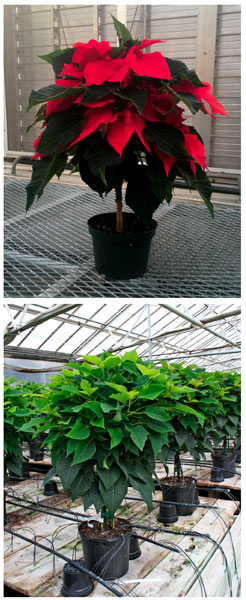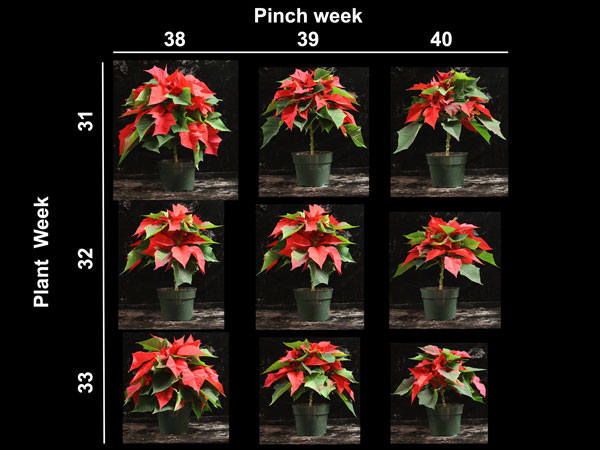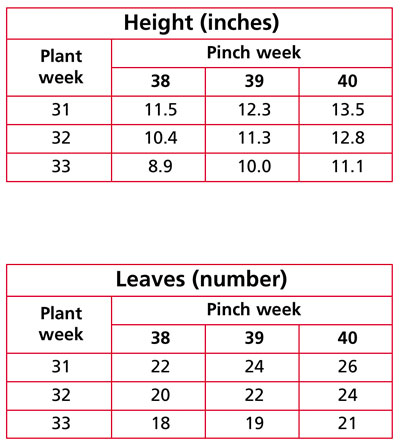5/1/2023
Just a Pinch
Patrick Youds & Christopher J. Currey

Fine-tuning tabletop poinsettia schedules.
One of the most striking poinsettia forms are trees and for good reason. Often several feet tall and in large containers, it’s hard not to appreciate these specimen plants. However, traditional trees in large containers have long production times and can require a fair amount of labor. Tabletop trees are a poinsettia form that takes the unique look of a single-stem “tree,” but are finished in smaller containers such as a 6-in. Older tabletop tree schedules have long production times and multiple pinches compared to the schedule we use.
To produce tabletop trees in 6-in. containers following the shorter schedule we use, plant cuttings nine weeks before short days and pinch them two weeks before short days. For perspective, planting happens three weeks before a regular 6-in. container is planted and pinched two weeks later than the 6 in. would be pinched. This schedule has served us well in the past, but we wanted to see how poinsettias with different vigor would finish with different planting and pinching schedules.
Pictured: Here’s a well-balanced and proportional tabletop tree finished in a 6-in. container.
• Traditional trees require long production times to produce trees proportional to the large containers.
Our research objectives were to determine how the time from planting and pinching, and pinching to short days, affected tabletop poinsettia tree growth for poinsettia cultivars varying in vigor. By determining how poinsettia vigor and planting pinch dates affect growth of tabletop poinsettia tree trunk (planting to pinch) and canopy (pinch to short days) development, we may be able to revise and improve our schedule for different cultivars.
The study
First, we selected three different red-bracted poinsettia cultivars varying in vigor for this study, including Enduring Red (medium-compact), Prestige Red (medium) and Imperial (medium-vigorous). Regardless of planting week or pinch week, all poinsettia cuttings were individually planted in 6-in. azalea containers filled with a soilless growing substrate comprised of 80% coarse-ground sphagnum peat moss and 20% coarse perlite, amended with limestone and a wetting agent.
Rooted poinsettia cuttings of Enduring Red, Prestige Red and Imperial Red were received from a commercial greenhouse (Plantpeddler, Cresco, Iowa). Each planting week (Weeks 31, 32 or 33), 30 cuttings of each cultivar were individually planted into containers. Then, on Weeks 38, 39 and 40, 10 plants from each planting week were pinched prior to short days starting on Week 41.
Regardless of planting date or pinch date, we targeted the same size pinch: a “medium” pinch, removing the growing point down one fully expanded leaf (the approximate length of these pinches varied slightly among cultivars). Our planting and pinching schedule resulted in nine different combinations of time from planting to pinching (six, seven or eight weeks) and time from pinching until short days (one, two or three weeks).
Throughout the study, plants were grown on expanded metal benches in a glass-glazed greenhouse. Day and nighttime air temperatures of 72F (22C) and 65F (18C), respectively, were maintained with natural ventilation, fan and pad cooling, and radiant hot water heating. Plants were hand irrigated throughout the study as needed with tempered municipal water providing 125 ppm N from a water-soluble fertilizer (15-5-15). Branches growing on the “trunk” below the “canopy” (those top seven or eight branches remaining below the pinch) were removed a few times during the study and leaves were removed from the trunk around halfway through short days.
The first data we collected was on plant height after pinching. Final growth data were collected on plants when anthesis, or pollen shed, was visible on cyathia. We measured the total height of the tree, as well as the height of the canopy (which also allowed us to subtract canopy height from total height to get trunk height).

What we found
When data were collected on plant height and leaf number at the time of pinching, we could see the effects of planting week. For example, when Prestige Red cuttings were planted on Weeks 31, 32 or 33, then pinched on Week 39, plant height decreased from 12.3 in. for cuttings planted on Week 31 to 10 in. for those planted on Week 33. Similarly, Prestige Red leaf number increased from 19 leaves for cuttings planted on Week 33 to 24 leaves for those planted on Week 31.
Pictured: Effect of planting week and pinching week on the height (including the container height) and leaf number of Prestige Red poinsettias after pinching. Short days began Week 41.
 In addition to planting week, pinch timing also affected plant height and leaf number. For example, when Imperial Red cuttings planted Week 32 were pinched Week 38, 39 or 40, plants were 9.8-, 11.2- or 12.4-in. tall, respectively, with 17, 20 or 22 leaves, respectively.
In addition to planting week, pinch timing also affected plant height and leaf number. For example, when Imperial Red cuttings planted Week 32 were pinched Week 38, 39 or 40, plants were 9.8-, 11.2- or 12.4-in. tall, respectively, with 17, 20 or 22 leaves, respectively.
Final data were collected once poinsettia cyathia were shedding pollen. Both the time from plant to pinching and pinching to short days affected canopy development, and this varied with cultivars. Total height for finished crops increased, as the time from planting to pinching, as well as pinching to short days, increased—similar to what we saw with height data taken at pinch.
The average canopy width of Imperial Red planted on Week 31 decreased from 19.5 to 17.4 in. as pinches were made three to one weeks prior to short days, respectively. Though we saw a similar trend on the effect of pinch time on canopy growth for plants planted in Weeks 32 and 33 as well, it was a less pronounced effect.
The same goes for the cultivar’s effect. For example, canopy grown of Enduring Red followed the same trend, but, as you might expect, the magnitude in change was less when compared to Imperial Red. The effect of planting date and pinch height had the same effect on canopy height as it did canopy width (data not shown).
How to use this information
Tabletop poinsettia trees need to have sufficiently sized trunks and canopies that are proportional to one another. The trunk size on a poinsettia tree is primarily a function of the height and leaf number of cuttings when they’re planted and the subsequent increase in height and leaf number that occur up to pinching. Canopy development on poinsettia trees is primarily influenced by the amount of growth that occurs on breaks from pinching until the start of short days. Just like with other pinched poinsettias, sufficient—but not excessive—vegetative growth is the goal prior to inductive short days. Working backwards from the start of short days, at least two weeks should pass between pinching until short days begin, increasing this time by an extra week or two for less-vigorous cultivars.
Additionally, while seven weeks of growth from planting to pinching works for standard or vigorous cultivars for developing the main stem, adding an extra week for more compact or less-vigorous varieties is beneficial.
The takeaway
Tabletop poinsettia trees are a relatively simple way to add a higher-value poinsettia form to your portfolio. While plant growth regulators can always be used to adjust growth as needed, this research can help you start with the right schedule. Always be sure to take into account differences in growing environments and cultural practices, and in-house trials are always recommended. GT
Patrick Youds is an undergraduate research assistant and Christopher Currey (ccurrey@iastate.edu) is an Assistant Professor in the Department of Horticulture at Iowa State University. This research was sponsored by the Fred C. Gloeckner Foundation.